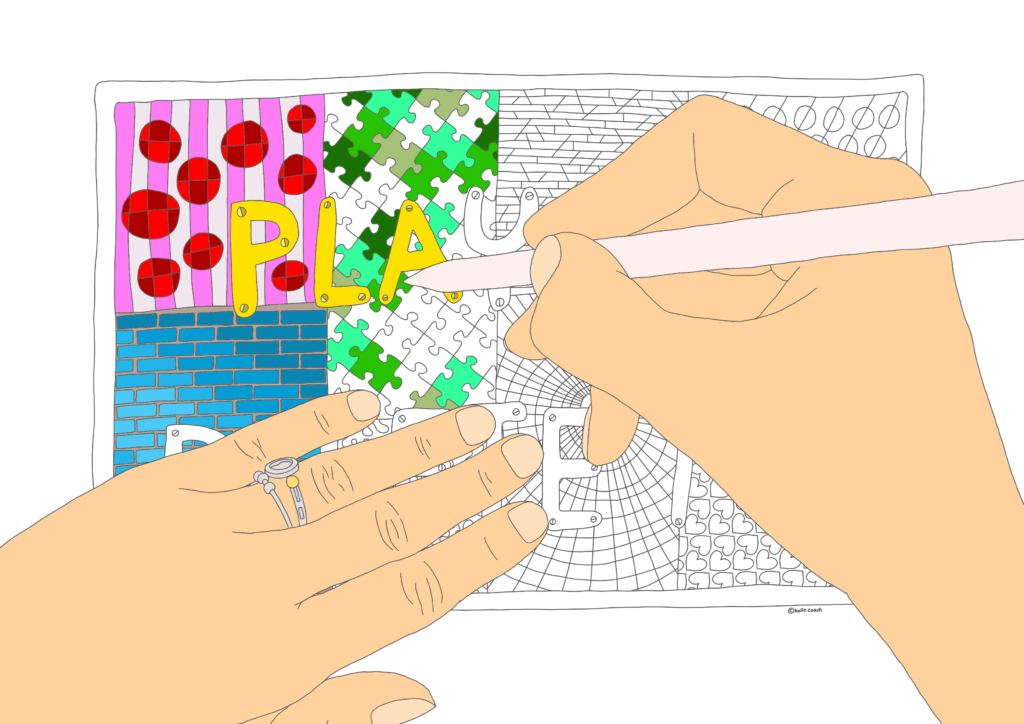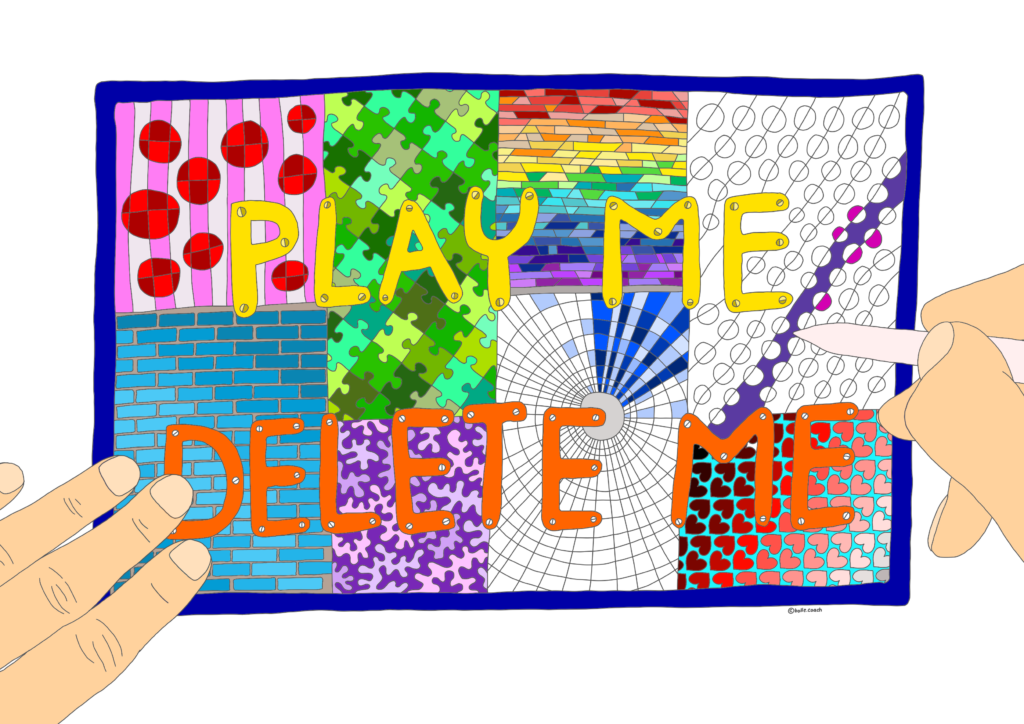Getting rid of an app addiction – and trading time for the better
It’s me again, sitting on the sofa, eyes fixed on a screen, tapping away at tiny squares that fill with vibrant color once the tip of my pencil hits the space. Boom – red, boom – another red, boom – and all reds are done. Let’s move to purple…
I am sucked into the pleasure of a children’s game, which is made for adults, and which gives me some destructive, paradox kind of joy. I know I am wasting my time. I for sure know.
Yet, this is FUN – let me do just one more image, just one more.
And – pooofff – time flies by.
And with it, my life.
The know-do discrepancy
I perfectly KNOW that I am wasting my time. And I perfectly KNOW that I don’t want that.
I have a long to-do list. I perfectly KNOW what I need to do to get closer to my objectives.
But a to-do list is not fun, you might think. So, it is understandable that you want a little distraction in between advancing on the serious things in life.
The paradox: There is not only work on this to-do list. I even have fun things on it, of all sorts, which I want to do and do not find the time for.
Yet, instead of doing all the things I really, really want to do (after thoughtful considerations) I sit with my eyes fixed on a screen and tap away on my journey to nothing-gets-done land.

How did I drive myself into this dead end – again?
How so there is this discrepancy of knowing what to do and actually doing it?
The embarrassing confession: I am addicted to a stupid thing…
It is not the first app I have been addicted to, but it seems to be the most stupid yet most joyful at the same time. It’s a sort of “paint-by-numbers” game. It’s embarrassing, I know…
And I won’t provide the name here, so that it is not my fault should you make the same mistake and fall for it.
Other apps I’ve played had at least some element of competition, some element of brain work or speed or other type of challenge.
This one, on the other hand, is so stupid that it is embarrassing to admit that I fell prey to it.
The only thing you need to be able to do is to tap with the tip of a pencil onto a little square or other shape so that a color can fill the space. Then you tap the next shape, then the next, and so on.
What on earth lets me play this stupid game?
I am on a quest to improve – i.e., increase – my productivity, to use my time well, THE ONE limited resource I have in this life. What is it that lets me come back to here even if after playing this stupid thing for a while my neck aches and my eyes sting?
Sitting still for extended periods of time, staring at one point right in front of your eyes, this is maybe one of the unhealthiest positions you can be in, and that is true from each and every angle you choose to look at it.
I. MUST. DELETE. THIS. STUPID. APP…!
… that seems to be smarter than I am
It’s a clear case, right?
Yeah…. I must delete it, for sure.
Not just now yet.
I will delete it tomorrow.
Or maybe I can keep it, just to secure my progress.
I don’t HAVE TO play it, right?
I can easily choose to not use it, right?
I can have it just sitting there, it will do no harm.
And in case I am traveling by train one day, and there is nothing else to do, and I am exhausted, and I am bored, and I could anyway not do anything useful while I wait, maybe I can THEN use it again.
Don’t need to use it every day, right?
Ok, so I will just keep it, let it sit there, unused, dormant. It will cost no money and nearly no space, so I will just keep it, just in case. This boring train ride will come, you know…?
24 hours later.
It’s me again, sitting on the sofa, eyes fixed on a screen, tapping away at tiny squares that fill with vibrant color once the tip of my pencil hits the space. Boom – blue, boom – another blue, boom – and all blues are done. Let’s move to green…
Just ONE more picture…
Thanks god – it killed itself
I don’t know how many times I went through this cycle.
The good news: In the end, I won.
At some point in time, I noticed a little gamification feature of the app. What is probably meant as a means to motivate you to spend more time on the app turned into my savior to break free.
The feature is this: Upon completing a picture, the app tells you how much “focus time” you have spent on it. What is probably meant to tell you how much time you have invested in your wellbeing and spirituality, it screamed at me how much time I had stolen from my future.
So, I did the math.
And this did the trick.
It is too embarrassing to admit how many hours I had wasted during the short time this app was on my phone. But… they were many… Too many. FAR too many.
I had a hard time, but finally, I deleted the app.
And this felt freeing.
And it made me curious about what had happened.
If the Dopamine hits, hit back!
Long before I won against the addictive app I had it very clear in my mind that I must delete it. Yet, it took quite some time until I finally did.
This KNOW-DO Discrepancy inspired me to do a thorough analysis of the reasons of my addiction to this particular app. I had been addicted to apps before, but this one was especially hard to get rid of.
Going through the functionality of the app, I found the following features that caused a tiny rush of dopamine:
The abundance and choice. There are hundreds of templates to choose from, each promising a nice experience and focus time. It is joyful to browse through the library and pick one image that matches your current mood.
The templates. Some of them meet my own illustration style and hence feel “mine”. They are partly beautiful, playful, motivating to tackle them. They make you curious, as the templates are black-and-white line drawings and you wonder how they would look when colored.
The joy of completing a color. Whenever you have “used up” one particular color, this is signaled by a micro-vibration of the phone and the color swatch disappears from the palette in a dramatic move – it flies away. This creates a certain sense of achievement – you have “finished” a part of the image, you have come a step closer to an “accomplishment”.
The joy of completing a complex shape. This feels like another achievement. Now, you have finished a certain area of the image – say, the background. I got something done, right?
The joy of completing a full picture. Ah, I did it. Doesn’t this look beautiful? “Achievement” again.
The surprise of how it turns out. Oh… THIS is how it looks. I would not have expected this bear to be BLUE.
The time lapse feature. Once you are done coloring, the app wraps it up in a little video showing how it came together. You can download a time-lapse showing the coloring process. You can even download this and “share”. As if I would like to share my embarrassing addiction… – but anyway, this is kind of interesting to watch.
The finished picture. Finally, the pictures are vibrant and beautiful (depending on your personal taste, of course). It nearly feels as if this picture was my work. Is there a glimpse of pride creeping in? Incredible… I feel deceived by my own emotions.
So, those are many moments already when dopamine hits. But it is not all. Check out those:
The daily summaries. This is meant to motivate you even more to stay on the app. When you have finished 4 or even 8 images per day, you get an overview page, summarizing all of them and celebrating the total “focus” time you have spent-wasted in the app.
The badges. Another layer of celebration – you can earn badges for all sorts of “achievements”. The number of images of a certain type or motive (patterns, animals, …), the number of pictures shared, … Not only do you earn a badge, but you then get bonus pictures added to your library as a “price”.
So, you can celebrate away your days.
At the same time, there is the underlying frustration that you KNOW you are wasting time. And you understand that within those endless opportunities – the hundreds of images in the library – you will never be able to get it all done.
And that’s what you want, right?
Get. Stuff. Done.
Wake up…!
Breaking the cycle
Of course, all those accomplishments are fake victory. Although you have finished something, you have finished nothing
The app feature of showing how much time I spent on it helped me to break the cycle.
I analyzed the time wasted – ups… that is dramatic. Had I spent this time in any useful way, I could have created X number of illustrations or animations of my own. I could have written X number of words. I could have slept X hours. I could have run X kilometers. There are many options that would have been better than sitting on my sofa, eyes fixed on a screen.
I analyzed the gain. All this dopamine, see above.
I analyzed the occasion, when I grab the phone to play this stupid thing. Those are times of exhaustion and the urge to escape from some unpleasant task or truth.
I took a decision. This needed to stop. Now.
I defined alternatives for the dopamine and relaxation. I can work on my own creations, exercise, sleep, read. Nearly ANYTHING would be better use of my time.
I decided to strike back. Not only did I delete the app, but I used this experiment for my own work – the very article you are reading just now. The enemy must be conquered. It can serve as post on my blog or a chapter in a book about procrastination that is yet to be written.
The App Addiction Buster Framework
In case you have the need – and be honest, you most probably DO have the need – to get rid of an app addiction, maybe the following considerations can help to break free from the cycle.
The addictive sequence works something like this:
Sense of craving ==> going for the quick fix ==> satisfaction
The idea is to implement a pause between stimulus and response like this:
Sense of craving ==> conscious choice ==> going for the better fix ==> satisfaction
A first step might be understanding the craving that drives you to grabbing your phone.
Here is a list of possible options to get you started:
Escapism. Games provide a way to escape reality, offering immersive worlds where players can forget their daily problems and stresses, disconnect from real-world responsibilities.
Achievement. Many games are designed around goals, milestones, levels, and rewards, which satisfy the human need for accomplishment. They give a sense of satisfaction and reinforce the desire to continue playing.
Social interaction. Multiplayer games and social features allow players to interact, compete and cooperate with others, creating a sense of community and belonging.
Challenge and competition. Games present challenges that require skill and strategy, which appeals to competitive instincts, can boost self-esteem and provide a sense of mastery and competence.
Curiosity and exploration. Many games feature intricate worlds and narratives that spark curiosity and a desire to explore new environments, which can be intellectually stimulating and satisfying.
Creativity. Some games involve building, designing, or creating, appealing to creative instincts and allowing players to express themselves artistically and fostering a sense of creativity and innovation.
Nostalgia. Many games are modern versions of classic games, triggering childhood memories and providing comfort by reconnecting with past experiences.
Control. Games offer environments where players can control outcomes and decisions, providing a sense of power and control often missing in real life. This can feel empowering.
Instant gratification. Games often provide immediate rewards and feedback, catering to the desire for quick pleasure. This can be highly addictive.
Routine and structure. Daily tasks and timed events create sense of structure, appealing to players who crave order and predictability, serving a sense of stability and purpose.
To find better options for a conscious choice to satisfy the craving, you may ask yourself the following questions:
| The quick fix (playing the app) | The better fix (the productive alternative) |
|---|---|
| Where does the dopamine come from? What is the craving, what gives you joy? (winning, achievement, finishing, helping others in virtual land…) | Where does a similar level of joy come from? Which activity will satisfy the craving and get you closer to your objectives at the same time? (exercising, writing, sleeping, making music, helping others in the real world…) |
| What energy level are you in when playing? (exhausted, tired, …) | What activity is at a similar energy level yet more useful? (resting, sleeping, reading, …) |
| When do you play? What time of day, occasion? (after work, in transit, when waiting, …) | What could you do in those moments instead? (thinking, practicing mindfulness, talking to a stranger at the bus stop…) |
| Where do you play? Is there a specific location? (sofa, train, bed, queue, …) | What else could you do at this place? Do you need to do anything, or can you just do nothing? |
| What is the trigger? (a craving, boredom, frustration, sadness, a word, a person, the tax papers waiting,…) | How can you consciously notice and break the trigger so that you can pause before acting? (notice the impulse, implement a warning, anchor a habit, remove tech from the bedroom, …) |
| Who are you when you play? (a child, a fighter, a wizard, …) | Who do you strive to be? (a writer, an adult, a boss, a sage, a healthy person…) |

The craving might not go away automatically, and it is hard to fight it via discipline. Willpower does last us so long only.
If you want to get rid of the bad habit, you choose an activity you want to do instead which gives you a similar level and a similar type of joy, i.e., which is similarly attractive, but which is more productive in the sense of achieving your objectives.
Rather than trying to resist the temptation, the idea is to re-channel it to a better way of fulfilling the need. Instead of “I must not…” it is about “I can…”.
Instead of restriction it is about increasing choice. Instead of being a victim, it is about becoming the captain.
And then, delete the app.
Get in Touch
What’s on your mind today? Share your thoughts and let’s connect.
